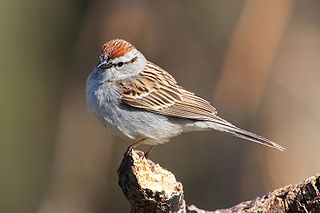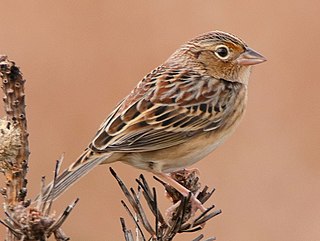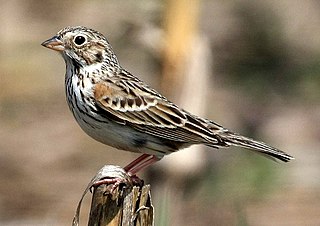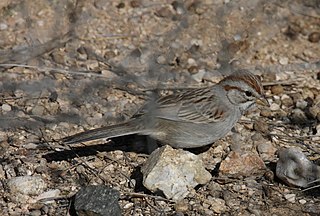
The white-throated sparrow is a passerine bird of the New World sparrow family Passerellidae. It breeds in northern North America and winters in the southern United States.

The chipping sparrow is a species of New World sparrow, a passerine bird in the family Passerellidae. It is widespread, fairly tame, and common across most of its North American range.

Cassin's finch is a bird in the finch family, Fringillidae. This species and the other "American rosefinches" are placed in the genus Haemorhous.

The lark sparrow is a fairly large New World sparrow. It is the only member of the genus Chondestes.

The willow flycatcher is a small insect-eating, neotropical migrant bird of the tyrant flycatcher family native to North America.

The grasshopper sparrow is a small New World sparrow. It belongs to the genus Ammodramus, which contains three species that inhabit grasslands and prairies. Grasshopper sparrows are sometimes found in crop fields and they will readily colonize reclaimed grassland. In the core of their range, grasshopper sparrows are dependent upon large areas of grassland where they avoid trees and shrubs. They seek out heterogenous patches of prairie that contain clumps of dead grass or other vegetation where they conceal their nest, and also contain barer ground where they forage for insects, spiders, and seeds. Grasshopper sparrows are unusual among New World sparrows in that they sing two distinct song types, the prevalence of which varies with the nesting cycle. The primary male song, a high trill preceded by a stereotyped series of short chips, is reminiscent of the sounds of grasshoppers and is the origin of this species' name. Like some other birds of the central North American grasslands, this species also moves around a lot, not only via annual migrations, but individuals frequently disperse between breeding attempts or breeding seasons. Grasshopper sparrows are in steep decline across their range, even in the core of the breeding distribution in the tallgrass prairies of the central Great Plains. The Florida grasshopper sparrow is highly endangered.

The vesper sparrow is a medium-sized New World sparrow. The only member of the genus Pooecetes, it is a pale sparrow with brown streaks that breeds across the grasslands of northern North America. It migrates to winter in the southern United States and Mexico.

LeConte's sparrow, also known as LeConte's bunting, is one of the smallest New World sparrow species in North America.

The double-barred finch is an estrildid finch found in dry savannah, tropical (lowland) dry grassland and shrubland habitats in northern and eastern Australia. It is sometimes referred to as Bicheno's finch or as the owl finch, the latter of which owing to the dark ring of feathers around the face. It is the only species placed in the genus Stizoptera .

The black-chinned sparrow is a small bird in the genus Spizella, in the New World sparrow family Passerellidae. It is found in the southwestern United States and throughout much of Mexico north of the Isthmus of Tehuantepec; most populations in the US migrate south after breeding while those in Mexico are resident. It is a slim, long-tailed bird, primarily gray with a reddish-brown back streaked with black, brown wings and tail, a pink beak, and brownish legs and feet. In the breeding season, the male shows black on his throat, chin, and the front of his face. Females, youngsters and nonbreeding males show little or no black in these areas. An unobtrusive bird, it spends much of its time foraging slowly along the ground, either alone or in small groups, sometimes mixing with other Spizella species. It is an omnivore, feeding primarily on seeds during the winter and insects during the summer. It builds a cup-shaped nest of grasses, rootlets, or plant fibers, into which the female lays 2–5 pale blue eggs. The female does most or all of the egg incubation, but both parents feed the hatched nestlings.

The rufous-crowned sparrow is a small American sparrow. This passerine is primarily found across the Southwestern United States and much of the interior of Mexico, south to the transverse mountain range, and to the Pacific coast to the southwest of the transverse range. Its distribution is patchy, with populations often being isolated from each other. Twelve subspecies are generally recognized, though up to eighteen have been suggested. This bird has a brown back with darker streaks and gray underparts. The crown is rufous, and the face and supercilium are gray with a brown or rufous streak extending from each eye and a thick black malar streak.

Botteri's sparrow is a medium-sized sparrow.

The rufous-winged sparrow is a medium-small, long-tailed New World sparrow with a gray face and rusty crown and supercilium; the rufous lesser coverts of the wing for which it is named are often concealed.

The crissal thrasher is a large thrasher found in the Southwestern United States to central Mexico.

Cassin's vireo is a small North American songbird, ranging from southern British Columbia in Canada through the western coastal states of the United States. This bird migrates, spending the winter from southern Arizona to southern Mexico.

Bachman's sparrow, also known as the pinewoods sparrow or oakwoods sparrow, is a small American sparrow that is endemic to the southeastern United States. This species was named in honor of Reverend John Bachman.

New World sparrows are a group of mainly New World passerine birds, forming the family Passerellidae. They are seed-eating birds with conical bills, brown or gray in color, and many species have distinctive head patterns.

Peucaea is a genus of American sparrows. The species in this genus used to be included in the genus Aimophila.




















